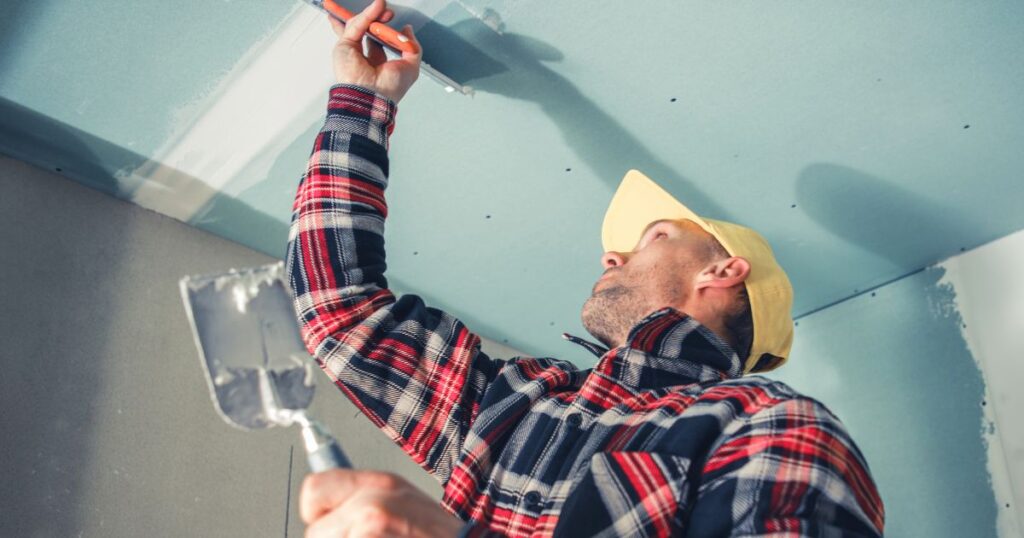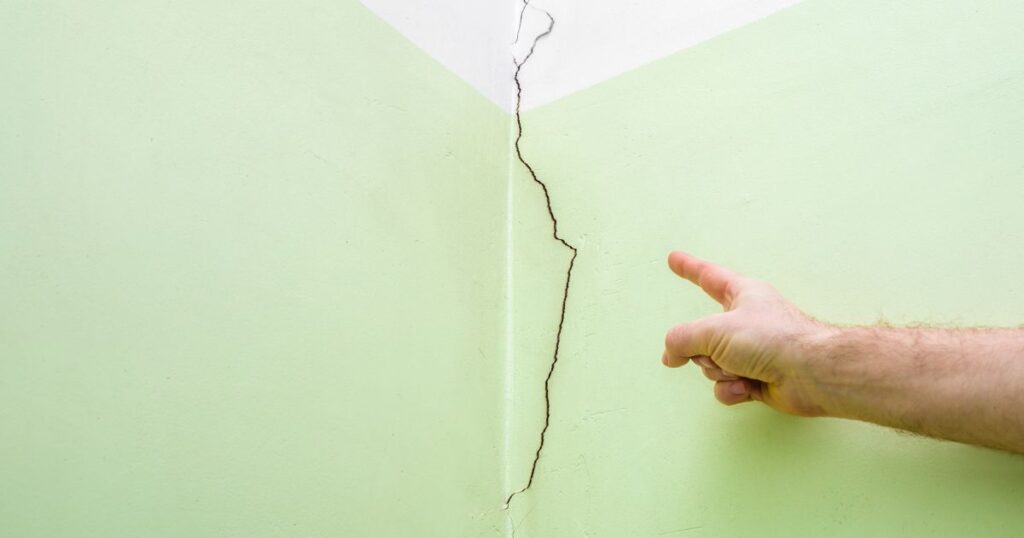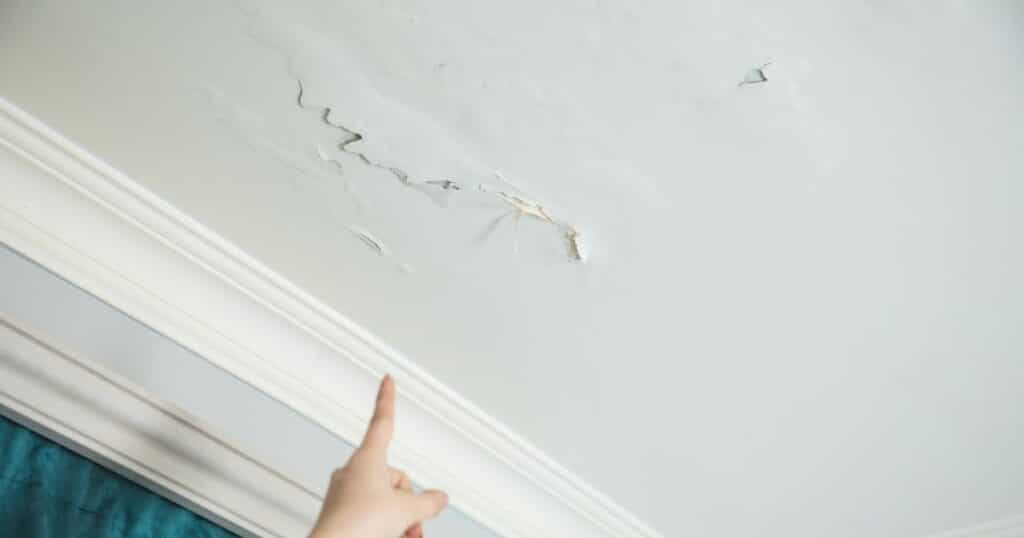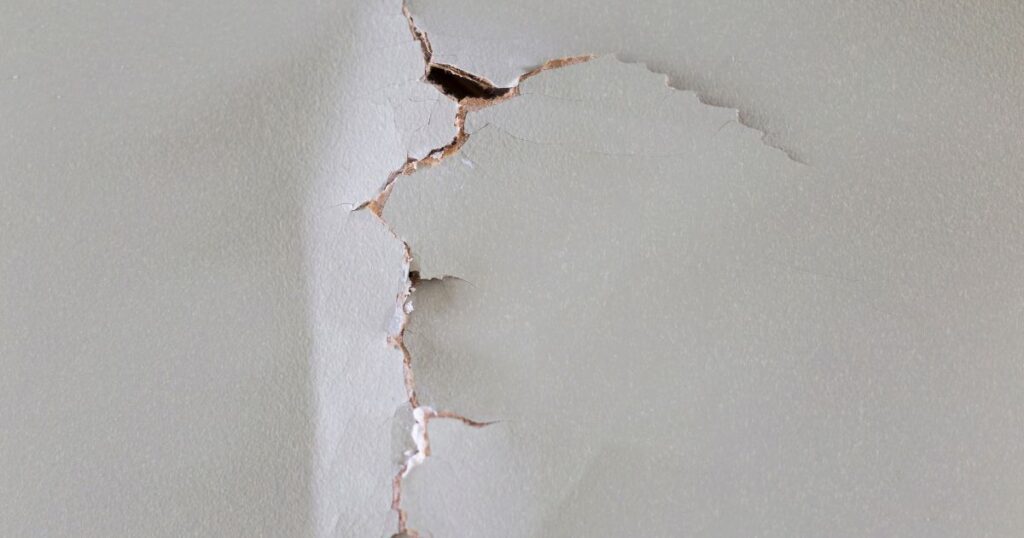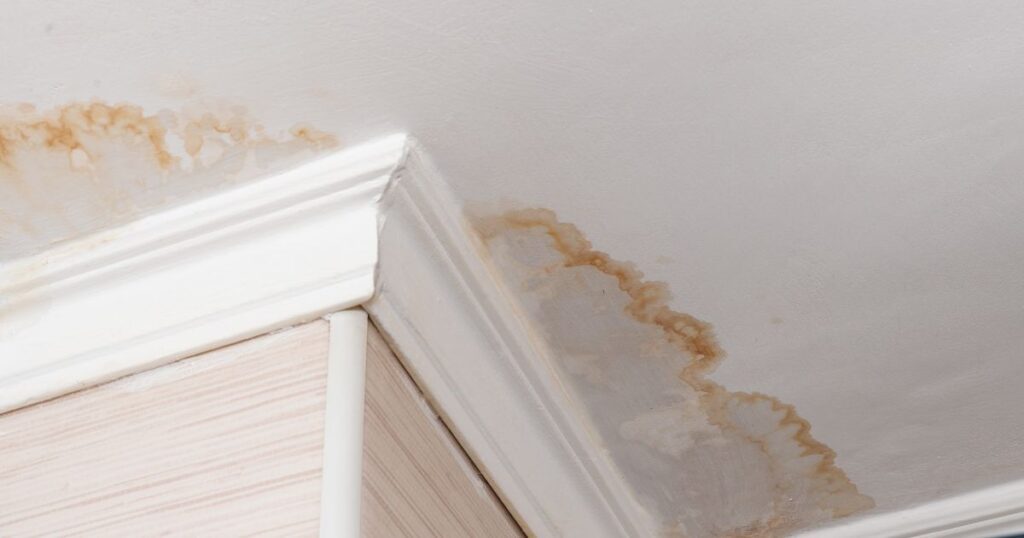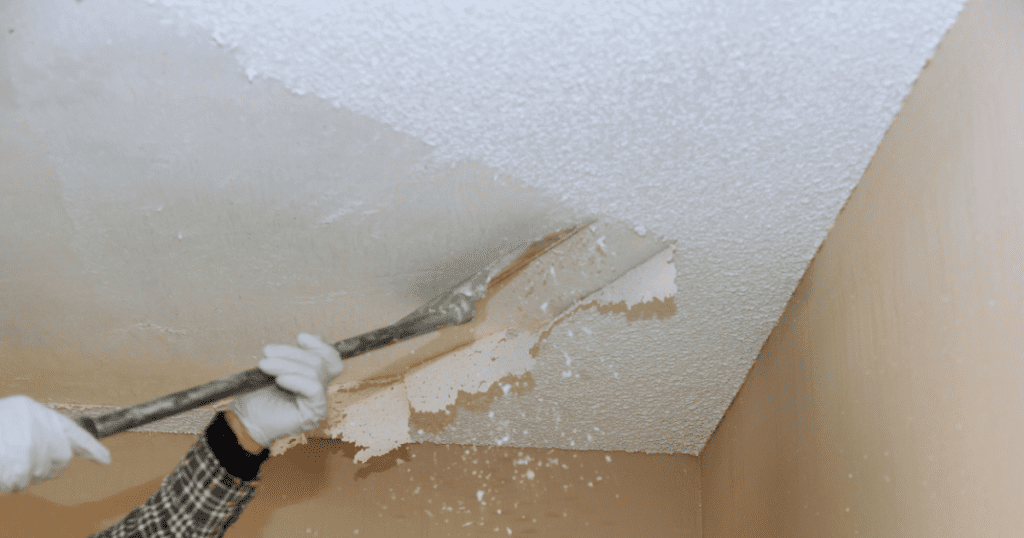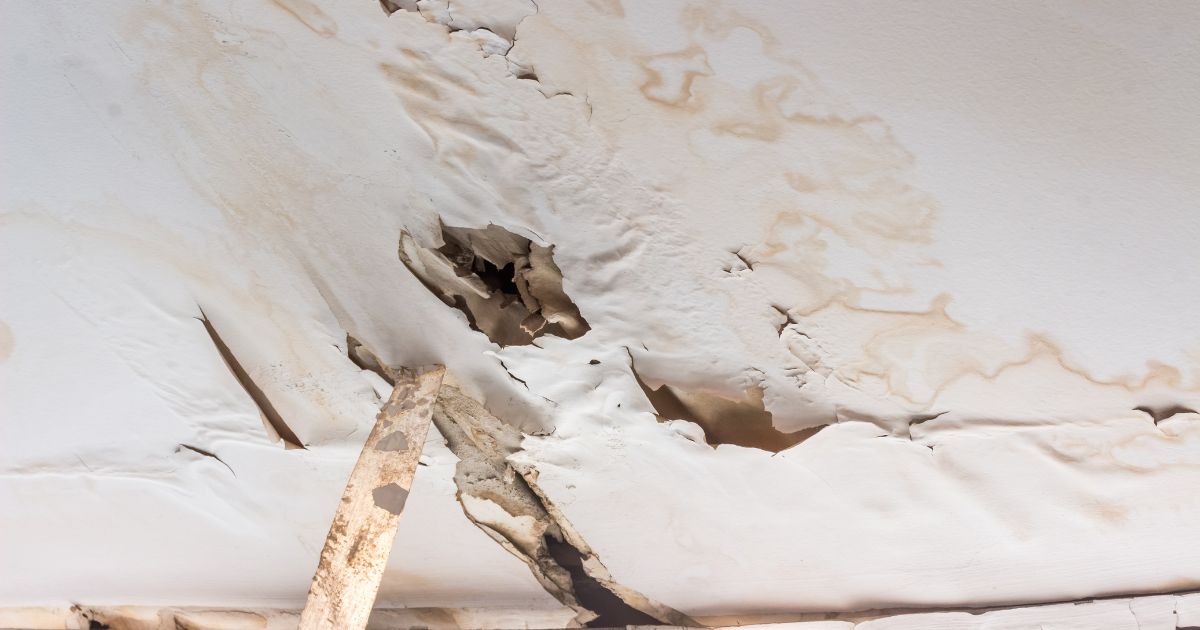
Explanation of water damage on the ceiling drywall
Water damage on ceiling drywall can occur due to a variety of reasons, such as leaky pipes, roof leaks, or natural disasters. When water seeps into the ceiling, it can cause discoloration, sagging, and even structural damage if left unattended. Water damage is not only unsightly but also poses a health risk due to the growth of mold and mildew.
Learn how to repair water damaged ceiling drywall in this detailed article. From assessing the damage to the finishing touches, we’ve got you covered.
Importance of repairing water-damaged ceiling drywall
Repairing water-damaged ceiling drywall is important for several reasons. First and foremost, it helps prevent further structural damage to the building by stopping the spread of moisture.
Secondly, repairing water-damaged ceiling drywall helps prevent mold growth which can lead to serious health issues for those who occupy the building. Restoring water-damaged drywall is crucial for aesthetic purposes as it prevents unsightly stains and discoloration from ruining the look of your home or business.
Overview of the repair process
Steps for repairing water damage on drywall vary depending on the extent of the damage. However, some general steps are usually followed. These include assessing the damage, preparing for repair by gathering necessary tools and materials while taking safety precautions, removing damaged drywall carefully without causing any harm to underlying structures especially if there is already some structural damage from prior leaks elsewhere in your property, drying out affected area using fans or dehumidifiers before installing new patching with new material which must be measured precisely so that it fits perfectly in place over where old material was removed from the surface area being restored to the original condition before any painting touch-up after water-damage occurs at all levels of restoration down to detailing minor imperfections with primers and sealants best suited for waterproofing and preventing future incidents requiring urgent attention
Assessing the Damage
Inspecting the Extent of the Damage:
The first step in any water-damaged ceiling drywall repair project is to assess the extent of the damage. This can be done by visually inspecting the ceiling for discoloration or water stains.
A small stain may only require a simple touch-up with paint, while larger stains could be an indication of a more significant issue. In my experience, most people underestimate how severe water damage can be to drywall and end up with a more extensive and costly repair project than they initially anticipated.
Identifying Any Underlying Issues That May Have Caused The Damage:
It’s not enough to just patch up visible signs of damage on your ceiling drywall – you need to identify and address any underlying issues that may have caused it in the first place. Water stains are often symptoms of leaks from faulty plumbing systems or roof damage, both of which require immediate attention from professionals. If you don’t fix these problems at their source, you’ll just end up with more water damage down the line.
Ceiling Water Stain Removal:
Water stains on your ceiling can be frustrating and unsightly. At times like these, it’s tempting to break out some bleach or other cleaning agents to try and remove them yourself- I urge you not to do this!
Bleach will only temporarily mask the problem without addressing its root cause. Instead, consult a professional who can identify where exactly the leak is coming from and what needs fixing.
Drying Wet Drywall
Structural Damage From Water Leaks:
When dealing with water-damaged ceiling drywalls, there are usually two distinct types of problems – aesthetic and structural. While we tend to focus on fixing visible aesthetic problems like water stains, it’s essential to remember that water damage can also weaken or even compromise the structural integrity of your ceiling. If you notice any structural damage (such as sagging or bulging), it’s paramount that you contact a professional right away.
Best Practices for Repairing a Water-Damaged Ceiling:
When it comes to repairing water-damaged ceiling drywall, there are protocols that need to be followed. The most important of these is ensuring that the affected area is completely dry before proceeding with any repairs. Failing to do so can cause mold and mildew growth, which can have long-term health implications and exacerbate your current problems.
Waterproofing Drywall:
One way to prevent future water damage on your ceiling drywall is by waterproofing it. There are many waterproofing products available on the market, but not all of them are created equal. I recommend consulting an expert in this field who can recommend best practices for waterproofing based on your specific situation.
Patching Water-Damaged Drywall
Steps for Repairing Water Damage on Drywall:
The process for repairing water-damaged ceiling drywalls involves cutting out damaged sections of drywall, drying out the affected area thoroughly, installing new drywall, and then painting or texturing it to match the existing ceiling. It may sound simple enough, but there are many nuances and challenges involved in each step – from properly measuring new drywall pieces to ensuring proper ventilation during drying.
Paint Touch-Up After Water Damage:
Once you’ve repaired the water damage on your ceiling drywall and applied paint or texture to match existing surfaces, you may find that further touch-up work is required after everything dries out fully. I advise against painting immediately after repairing; instead, wait for a couple of days before touching up any discrepancies between new versus old paint thickness. Patience is key when dealing with water damage repairs, especially when it comes to aesthetics.
DIY Water Damage Ceiling Repair:
Some people opt for DIY water damage ceiling repair projects, but this can be risky – particularly if you’re not experienced or don’t have the right tools and materials on hand. In my experience, it’s best to leave water damage repairs to professionals who have the expertise and equipment needed to tackle even the most challenging projects.
Preparing for Repair
Gathering necessary tools and materials
Before embarking on any DIY project, it is essential to have the right tools and materials at hand. When dealing with a water-damaged ceiling, you’ll need more than just a hammer and nails.
You’ll require a utility knife, drywall saw, screwdriver or drill, joint compound, drywall tape or mesh, sandpaper (120-grit), paintbrushes (varying sizes), and sufficient amounts of drywall sheets. The list can go on depending on the extent of the damage and whether you’re looking to make repairs temporarily or permanently.
Ensure that you purchase high-quality supplies from credible suppliers to avoid further damage from inferior products. Make sure that you have enough supplies before starting repairs, as this ensures that the process is smooth.
Clearing out furniture and other items from the affected area
Now that you have all your tools lined up, what about the furniture?
Before starting repairs, it’s critical to remove all furniture in rooms with water-damaged ceilings. This minimizes further damage to your valuables while allowing for more space to work effectively. Start by removing everything within a safe distance around the affected area.
For instance, if water has leaked through your ceiling in one spot only, move everything at least ten feet away from this spot. If possible, move items into another room altogether until you’re done with repairs.
Taking safety precautions
Water-damaged ceilings pose several hazards during repair: structural damage from water leaks is one of them. The first step towards minimizing such risks is turning off power sources near the damaged area—a wet environment can cause electrical shocks when handling electronic devices like power drills.
It’s also advisable to wear protective gear such as gloves and face masks when working in damp areas since mold can grow within 24 hours after moisture buildup. Ensure that the work area is well-lit using artificial lighting to reduce the risk of slips and falls.
Drying wet drywall
Before you begin repairs, ensure that the ceiling is completely dry. The process may take some time, depending on the extent of the damage.
Use fans and dehumidifiers to dry out the affected area quickly. Check for signs of moisture regularly until it’s entirely dry.
Removing excess water from damaged areas helps to prevent mold growth and other health hazards. If necessary, consider hiring professionals who have specialized tools and equipment to speed up the drying process.
Waterproofing Drywall
Even after completing repairs, it’s crucial to take future measures to prevent water damage to your ceiling. One way of doing this is by waterproofing your drywall by applying a waterproof sealer on walls or ceilings prone to leaks.
Waterproofing materials prolong your ceiling’s lifespan by reducing water absorption and preventing mildew growth in damp areas such as bathrooms or basements. Preparing for repair when dealing with a water-damaged ceiling requires adequate preparation both in terms of materials and protective gear.
Clearing out furniture ensures that you have more space to work while taking ample safety precautions to minimize risks during repairs. Drying out damp areas help prevent further damage, while waterproofing ensures lasting protection against damages from future leaks or flooding.
Removing Damaged Drywall
Cutting out damaged sections of drywall
One of the most important steps in repairing water-damaged ceiling drywall is removing the damaged sections. It’s not uncommon for homeowners to try to salvage parts of the wet drywall that they think might still be usable, but this is a recipe for disaster.
Even if a small section of drywall appears to be intact, it could still harbor moisture and mold that can spread to other areas. So don’t take any chances – when in doubt, cut it out!
Cutting out the damaged sections requires careful planning and precision. First, you need to mark off where you’ll make your cuts.
A utility knife or rotary saw can be used for precision cutting – just make sure you’re using sharp blades. Wear protective gear like gloves, a mask, and goggles while cutting because drywall dust can be harmful when inhaled.
Carefully removing debris
After cutting out the damaged sections of ceiling drywall, it’s time to remove all debris carefully. Do not leave any scraps behind, as they can become points of entry for moisture and mold growth later on.
Use a broom or vacuum cleaner with a HEPA filter attachment to clean up any loose pieces left behind from cutting out the damaged ceiling drywall. You must also pay attention to any electrical wires or pipes running through the ceiling before cutting so as not to damage them during removal.
Inspecting underlying structures for further damage
When you cut into your water-damaged ceiling drywall, what lies beneath could also have been affected by water damage that may have gone unnoticed until now. Before moving on with repairing your ceiling’s drywalls, inspecting underlying structures such as wood beams or joists is essential.
If there are damages here, too- like warping or signs of rot- then repairing the drywall on the ceiling is just a temporary fix. The wet beams may need to be replaced, or structural damage may need professional repair.
It’s imperative to get a professional opinion if you’re unsure about any potential damage. Otherwise, a DIY approach may leave you with an unsafe structure that can lead to further problems down the line.
Drying wet drywall
Before you can install new drywall, it is essential to ensure that all moisture has been removed from the area. In case there’s still any dampness in the room, use fans and dehumidifiers for drying out wet drywall and maintaining good airflow in the room. Adequately drying out your ceiling before installing new drywall is vital for two reasons.
First of all, it prevents mold growth on your ceiling as moisture promotes fungal growth. Secondly, it ensures that the new material installed won’t become water damaged soon after installation.
Waterproofing Drywall
If there are no underlying structural damages found after inspecting your ceiling’s frame and everything seems okay now, it’s time to install new drywall. But instead of using regular gypsum boards, as they are prone to water damage when exposed to moisture or high humidity levels, consider using waterproof or mold-resistant types of drywall which are specifically designed for damp environments like bathrooms or laundry rooms. Water-resistant gypsum boards have additives like fiberglass or other synthetic materials that make them more impervious to water than traditional plasterboard sheets.
Removing damaged areas of wet ceiling drywalls is essential when repairing water-damaged ceilings in homes. When cutting out damaged sections of drywalls, caution must be taken not to cause further destruction while removing debris from cutouts.
Inspecting underlying structures-wood beams/joists- should be done before moving on with repairs as they could also have been affected by water damage that may have gone unnoticed until now. Drying out wet drywall and using waterproofing drywall are two additional steps you can take to prevent further water damage to your ceiling.
Drying Out Affected Area
Using Fans and Dehumidifiers to Remove Moisture from Affected Area
When it comes to repairing the ceiling after water damage, drying out the affected area is a crucial step in the process. However, some people might think that simply opening windows or doors can help remove moisture. This is not true, as it only allows humid air in and does very little to dry out the area.
Using fans and dehumidifiers are two of the best practices for repairing a water-damaged ceiling. Fans will help circulate air, which can speed up the drying process.
On the other hand, dehumidifiers remove moisture from the air by condensing it into a container or draining it outside. While both fans and dehumidifiers are essential in drying out an affected area, they must be used cautiously to avoid further damage.
Too much heat can cause problems like structural damage from water leaks or even electrical fires. Instead of relying on heat sources like space heaters or hairdryers, opt for gentle and steady airflow that will gradually remove moisture.
Monitoring Progress to Ensure Complete Drying
One of the biggest mistakes that people make when restoring water-damaged drywall is assuming that once visible signs of moisture have disappeared, everything is dry. Unfortunately, this is not always true because there could still be excess moisture trapped inside walls or ceilings, which can lead to mold growth over time.
Ensuring complete drying after fixing water stains on the ceiling or wall surfaces requires careful monitoring over time with humidity meters until all residual dampness has been removed. Even if you use fans and dehumidifiers correctly but don’t follow through with proper monitoring of progress until completion, your hard work could be for naught!
Therefore, homeowners must take their time when dealing with water damage restoration, as rushing through things might only worsen the damage. Patience is the key when drying out an affected area, and it’s worth taking a bit longer to ensure that every part of the ceiling is entirely dry before moving on to the next step.
In addition to using fans and dehumidifiers, it’s best to take some time off from regular activities like cooking or showering in a room with water damage. As you can imagine, these activities increase humidity levels in your home, which only adds more moisture to the already humid air that must be removed.
It’s essential not to skip any steps in this process as this will only set you back in fixing a water-damaged ceiling. If anything seems too complicated, don’t hesitate to call for professional help, as more extensive water damage mitigation may require attention beyond DIY methods.
Installing New Drywall
The Right Way to Measure and Cut New Drywall for Your Ceiling
You can’t just slap a new piece of drywall on your ceiling and expect it to look good. Proper measurement and cutting are essential steps in the process of repairing water-damaged drywall.
The best way to do this is by using a measuring tape and a straight edge. Make precise measurements and then use a utility knife or saw to cut the drywall accordingly.
When measuring for your new drywall, do not forget to factor in any gaps or spaces between the ceiling joists that will be required for fitting the new sheet in place. Avoid creating oversize gaps, as they will require extra mudding work later.
At the same time, make sure not to cut too much off from your sheet, as you want it to fit snugly into place. Keep track of which side of the drywall you want facing down towards your room so you won’t have any issues when it comes time for taping.
How To Secure Your New Drywall In Place Properly
Once you have properly measured and cut your new drywall piece, it’s time to secure it into place with screws or nails. Start with driving screws or nails around the edges of each piece about every six inches apart from each other before working further inward.
Be mindful not to drive them too hard, as this might cause further damage to already weakened structures from water damage mitigation efforts. Using a drill with a screwdriver bit is recommended while hammering nails work if necessary.
However, don’t overdo either method, as overdriving screws might cause warping while excessive hammering might also weaken structures even further. Drive in any remaining screws or nails throughout each sheet’s center until it is secure.
The Trick to Taping, Mudding, and Sanding Seams Until They’re Smooth
After securing your new drywall in place, next comes taping. This process involves securing the seams between each sheet with tape before applying mud, then sanding down the excess until it’s even and smooth. To tape your seams, start by applying a thin layer of joint compound or “mud” along both sides of the seam with a drywall knife or similar tool. Then press drywall tape firmly into the compound while using a wedge tool or putty knife to smooth out any air bubbles.
Once you’ve taped each seam, it’s time to apply additional coats of mud in thin layers at least two more times.
Allow sufficient time for each coat to fully dry before sanding them off gently with a fine-grit sandpaper. It may sound like a lot of work, but taking your time while using the correct techniques will leave you with flawless results and make paint touch-ups after water damage restoration easier.
Finishing Touches
Painting or Texturing New Drywall to Match Existing Ceiling: Tips and Techniques
Patching water-damaged drywall is just the first step in repairing a water-damaged ceiling. Once you have put up new drywall, you need to paint or texture it so that it blends seamlessly into the rest of the room.
For many homeowners, this is where things start to get tricky, as matching texture and color can be quite challenging. When it comes to painting new drywall, one of the most important things to keep in mind is that you need to prime it first.
Primer helps create an even surface and prepares the drywall for paint. Once you have primed your drywall, you can start painting.
Depending on how big an area you are painting, you may want to use a roller for larger sections and a brush for smaller ones. If your ceiling has a textured finish, matching that texture can be especially difficult.
There are several techniques you can use to try and achieve a similar look when texturing new drywall. One popular method is known as “orange peel,” which involves spraying joint compound onto the surface with a hopper gun and then lightly flattening it with a trowel.
Another option is to try and replicate the texture using a sponge or other household item. Dip your sponge into some joint compound or plaster and dab it onto the new drywall in random patterns until you achieve a similar finish.
Reinstalling Light Fixtures or Ceiling Fans: How To Do It Safely
Once your new drywall has been painted or textured, it’s time to reinstall any light fixtures or ceiling fans that had to be removed during repairs. However, before doing so, make sure that all electrical connections are secure and there are no exposed wires. To begin reinstalling light fixtures or ceiling fans, first, turn off the power to the circuit that controls them.
Then, carefully remove any screws or mounting brackets that are holding the fixture in place. Make sure to support the fixture with one hand as you do so, to prevent it from falling and causing damage or injury.
Once you have removed the old fixture, it’s a good idea to check if there are any signs of water damage or mold on the wiring or housing. If there are, these will need to be addressed before you can safely install a new fixture.
When installing a new light fixture or ceiling fan, make sure that it is securely fastened and leveled. Use appropriate hardware and follow manufacturer instructions for best results.
Finishing touches are an important and necessary part of repairing water damage on drywall. Painting or texturing new drywall to match existing ceilings can be challenging, but with proper techniques, such as priming and using a hopper gun, you can achieve great results.
Reinstalling light fixtures properly is also crucial for safety reasons and requires turning off power while making sure everything is secured and leveled properly. With best practices for repairing water-damaged ceilings, such as waterproofing drywalls and preventing mold growth in mind made during repairs, your ceiling will look just like brand new!
Frequently Asked Questions
Can water damaged ceiling be fixed?
Water-damaged ceilings can typically be repaired by addressing the underlying cause of the damage, drying the affected area, and restoring or replacing damaged materials.
Should ceiling drywall be replaced if it gets wet?
In many cases, wet ceiling drywall should be replaced to prevent potential mold growth and structural damage. Prompt replacement is advisable, especially if the drywall has been saturated or if there are signs of significant damage.
Is it OK to paint over a water-damaged ceiling?
Painting over a water-damaged ceiling is not recommended without first addressing the underlying cause of the damage and properly repairing and drying the affected area. Simply painting over water damage can lead to further issues, such as mold growth and structural deterioration.
Will a wet ceiling dry on its own?
In some cases, a wet ceiling may dry on its own, particularly if the source of the water damage has been resolved and the area is adequately ventilated. However, it is important to assess the extent of the damage and take appropriate actions such as thorough drying and repairs to prevent further issues.
How long does it take for the ceiling to dry after water damage?
The time it takes for a ceiling to dry after water damage can vary depending on several factors, including the extent of the damage, the materials involved, the climate conditions, and the drying methods employed. It can range from a few days to several weeks, and in some cases, professional assistance may be required.
Can a ceiling collapse from water damage?
Severe and prolonged water damage can compromise the structural integrity of a ceiling, potentially leading to a collapse. It is crucial to address water damage promptly and thoroughly to prevent such risks and ensure the safety of the building’s occupants.
Conclusion
Recap of the repair process
Repairing water damaged ceiling drywall can be a daunting task, but following the right steps and being patient in the process is essential. This article has outlined various steps that can help you restore your ceiling to its former glory. The first step is assessing the extent of damage and identifying any underlying issues that may have caused it.
Then, you should prepare for repair by gathering necessary tools and materials, clearing out furniture and other items from the affected area, and taking safety precautions. Once you’ve prepared for repairs, removing damaged drywall is critical to enable you to inspect underlying structures for further damage.
Drying out the affected area using fans and dehumidifiers will also help remove moisture from the damaged area. When installing new drywall, measuring and cutting new drywall to fit into the affected area will ensure that it fits correctly.
Finishing touches are also vital when repairing water-damaged ceiling drywall. Painting or texturing new drywall to match the existing ceiling or re-installing light fixtures or ceiling fans will give your ceiling a polished look.
Importance of addressing water damage promptly to prevent further issues
Promptly repairing water-damaged ceiling drywalls is critical because untreated leaks can lead to structural damage in your home or cause mold growth within 48-72 hours of being wet. Mold growth in turn could lead to harmful living conditions, which could cause health complications like asthma attacks, allergies, or other respiratory problems.
Moreover, allowing moisture into your home creates an environment where bacteria thrive, making it hazardous for people who suffer from asthma or allergies, thus causing more health complications over time if left unattended. In such cases, it’s best not only to repair any damages promptly but also take preventive measures such as fixing leaks before they develop into major problems.
Repairing your water-damaged ceiling drywall is an important responsibility that should not be taken lightly. This is especially true since it can negatively impact the structural integrity of your home and the health of your family.
By following the steps outlined in this article, you can quickly repair your ceiling and prevent any further issues from arising. Remember, prevention is always better than cure, so do not hesitate to address any leaks or damages as soon as they occur.

